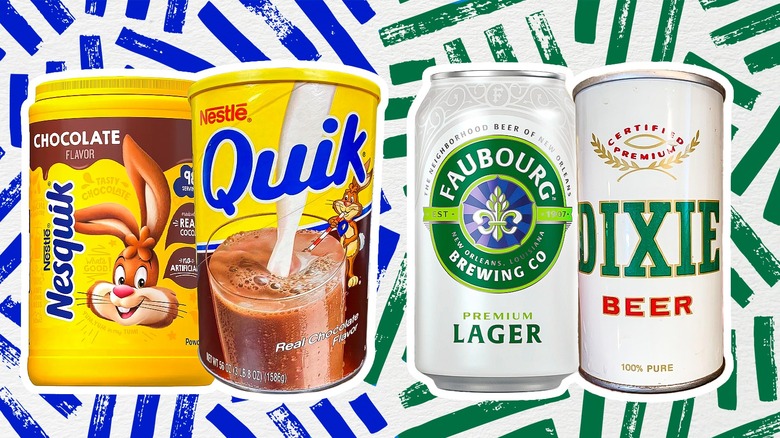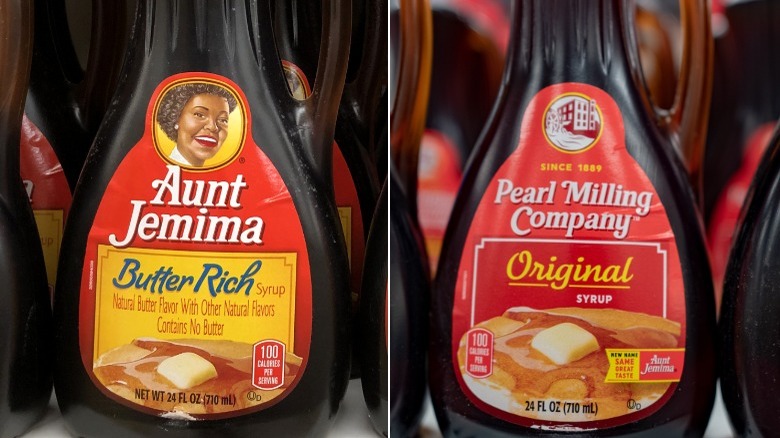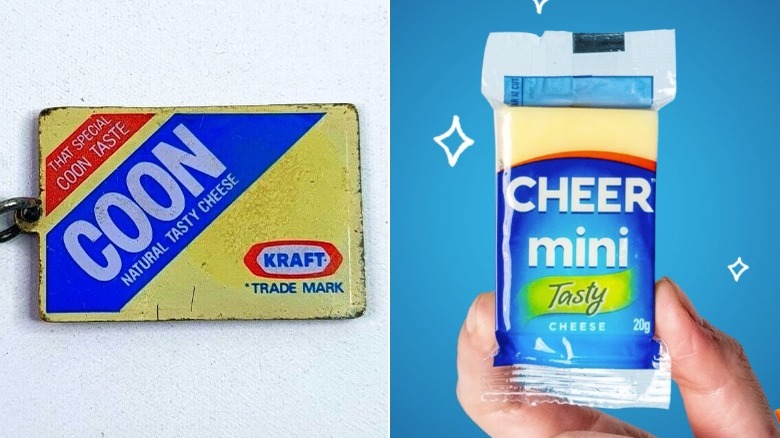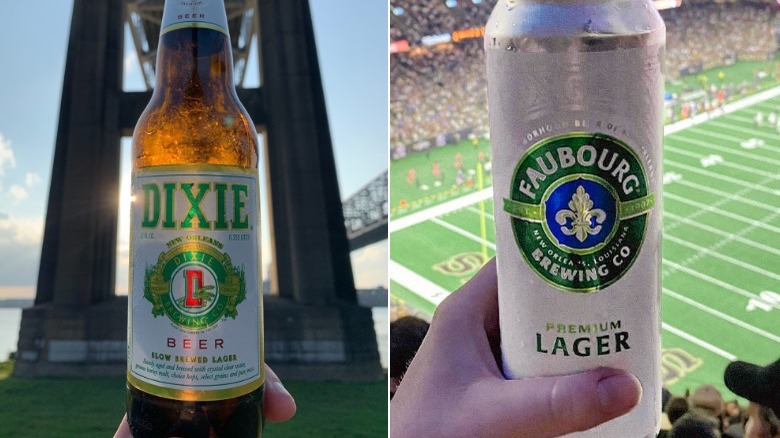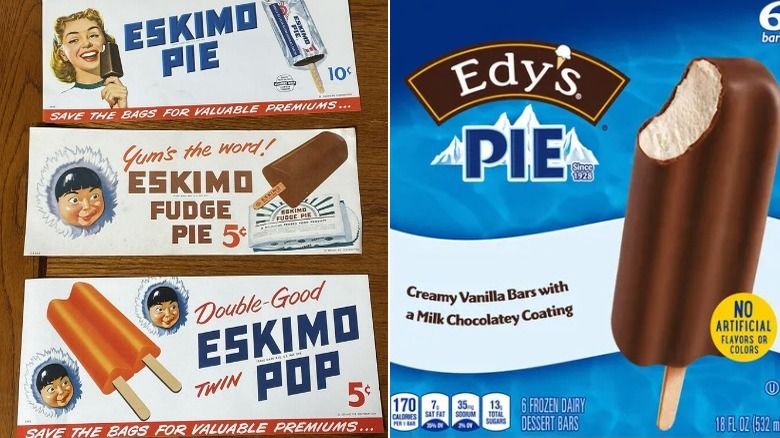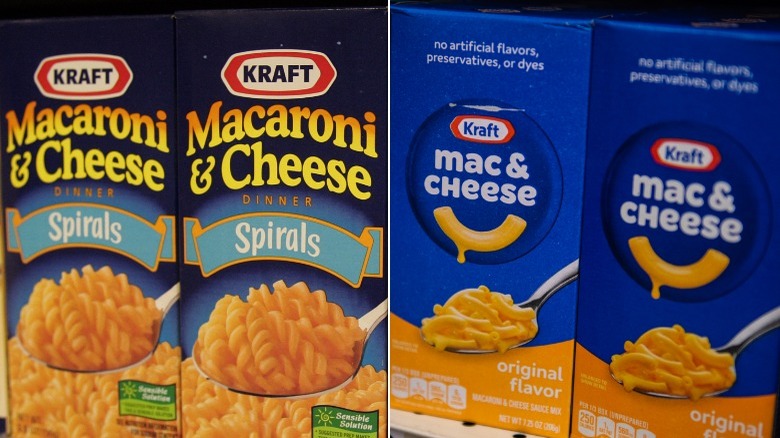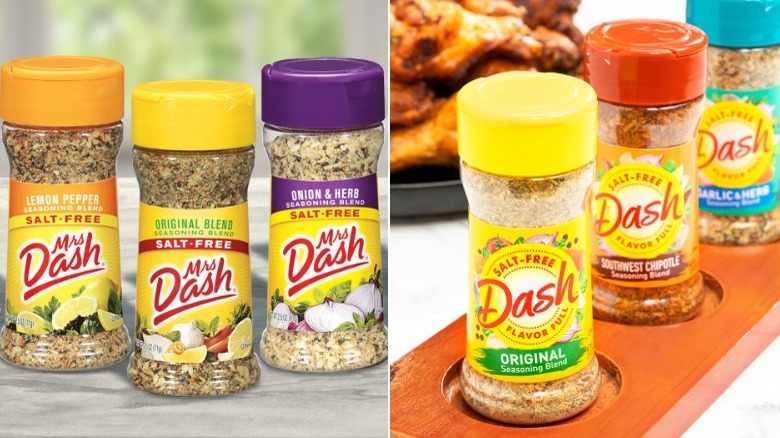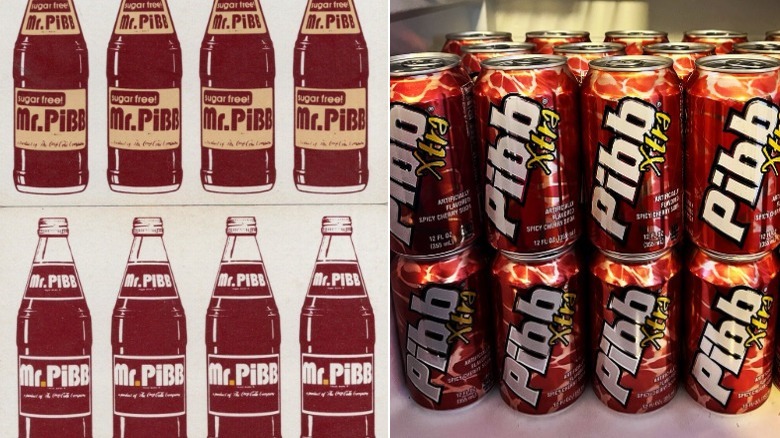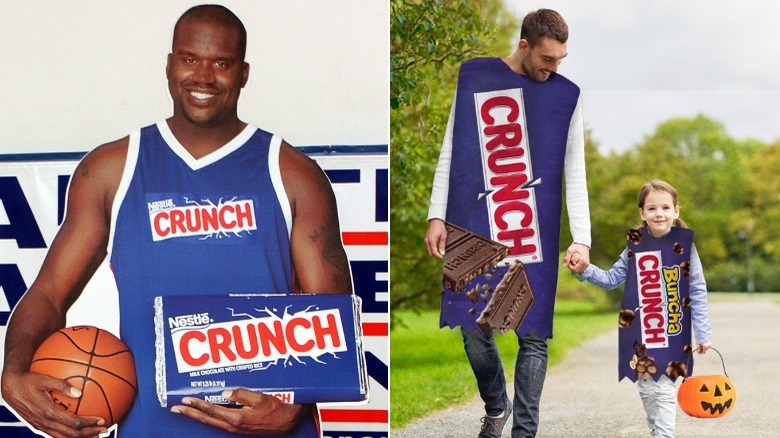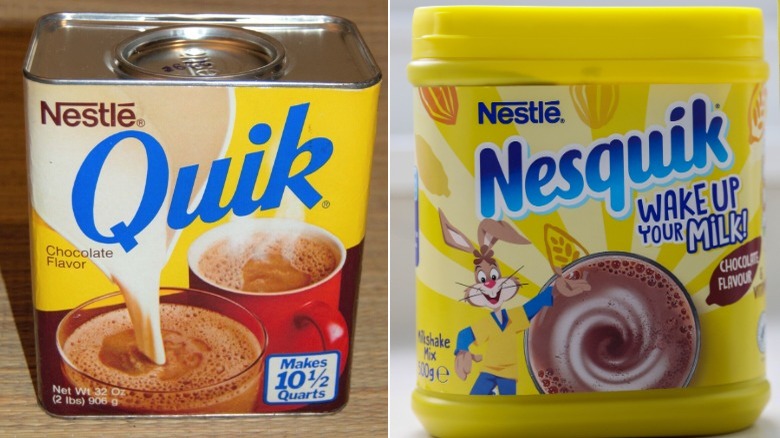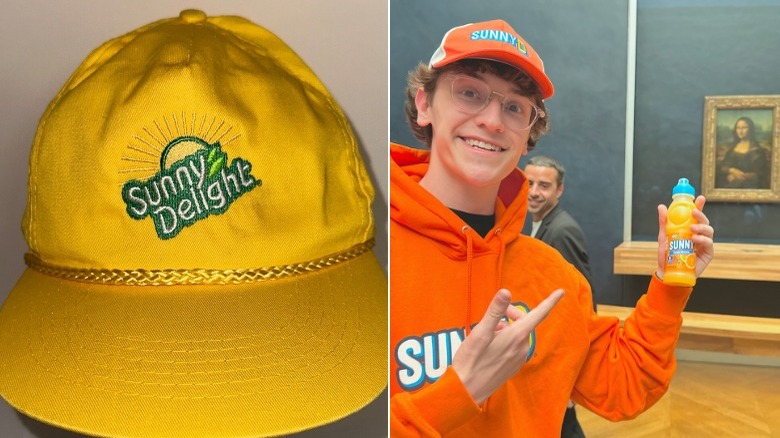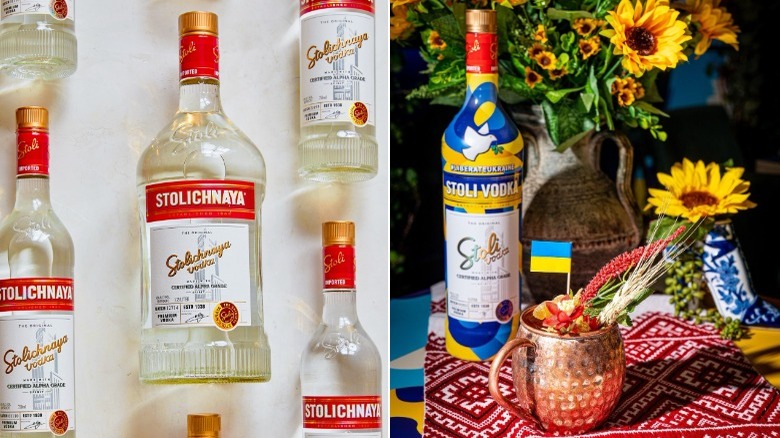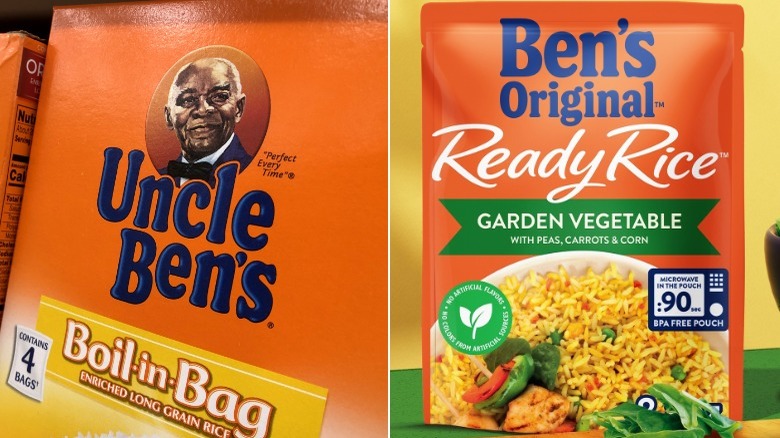12 Food Brands That Changed Their Names
The name and iconography of a food or drink brand are just as important as the product itself. Emblematic logos, familiar mascot faces, and comforting packaging designs are always a welcome sight in a supermarket, luring customers to buy the product time and again. However, as years pass, people's tastes and beliefs change, and sometimes a name once beloved and revered becomes a bit touchy, taboo, or downright offensive. When this happens, brands may wish to rework their names and designs to absolve themselves from past perceptions of which they might have been connected. In other cases, brands simply need to freshen up their look and moniker to appeal to newer generations and customers.
Name changes are nothing new in the world of food and drink. Everything from fast food restaurants to products found in grocery stores around the globe have been re-branded in the past few decades. We've collected the stories of 12 iconic products that now live under new names, even if many of us still call them by their old monikers.
1. Aunt Jemima > Pearl Milling Company
When Chris Rutt was looking for a homey name to give the world's first self-rising pancake flour, he found inspiration in the minstrel song "Old Aunt Jemima." The song was written in 1875 by African-American musician Billy Kersands, but the name "Aunt Jemima" dates back as far back as 1804. Rutt and partner Charles Underwood's Aunt Jemima products were produced and sold by their company — Pearl Milling Company.
Aunt Jemima took on a human form when former slave Nancy Green was hired to embody her at The World's Columbian Exposition of 1893 in Chicago. She received a fictional backstory outlined in "Life of Aunt Jemima" as a plantation cook whose pancakes become beloved by her owner Colonel Higbee, and then by everyone else.
In the 20th century, Aunt Jemima became one of the most popular pancake and syrup brands. For a time, there was even a restaurant at Disneyland. However, calls for a name and image change grew after the civil rights movement of the 1960s, and reached a boiling point after the death of George Floyd.
In June 2020, current owner Quaker Oats decided to change the name. In a press release, the company said, "to further evolve the brand and make it one everyone can be proud to have in their pantry." That following summer, Aunt Jemima and her likeness were gone from packaging. The brand's new name honors the very first company that started it all: Pearl Milling Company.
2. Coon Cheese > Cheer Cheese
American Edward William Coon patented an improvement in a process for ripening cheese in 1926. His work soon caught the attention of Melbourne cheese maker Fred Walker, who partnered with Kraft to form the Kraft Walker Company. It released a red wax-covered cheddar cheese called Red Coon in 1933, with its name honoring the pioneering inventor.
While the cheese was named after a man, the word "coon" was also a well-known offensive term for those of African decent. Ann Weldon, of the Aboriginal Children's Service, questioned the name, telling The Age in 1988, "It comes across as offensive even if it isn't meant to be," adding that she didn't personally buy the product due to its name.
In 2020, current owner Saputo Dairy Australia decided to address the issue. The company reiterated its connection to Edward William Coon, but noted that it was time for a name change. In a press release, it stated, "We believe we all share in the responsibility to eliminate racism in all its forms and we feel this is an important step we must take to uphold this commitment." Six months later, Saputo officially renamed the product Cheer Cheese, which the company says is "a cheese for everyone, and we trust our valued consumers and those who are new to our products will embrace this new name."
3. Dixie Beer > Faubourg Brewing Company
Dixie Brewing Company opened its doors in 1907 thanks to founder Valentine Merz. Miraculously, it was able to survive prohibition, big brand competition, and even Hurricane Katrina. For a long time, it was only sold in Louisiana, and later to other southern states.
In 1983, Dixie President Robert Oertling likened his product to a "part of the heart and soul of New Orleans." However, he was forthright about the brand's lack of inclusivity. He told The Town Talk, "We have a problem in that we don't sell much Dixie in the black community. It's something that we have always gone after and it is a market that we have not been able to crack."
In 2017, New Orleans Saints and Pelicans majority owners Tom and Gayle Benson added Dixie to their portfolio and three years later Gayle oversaw the brand's name change. The public submitted 5,400 name ideas and the winner was Faubourg (pronounced "Fo-Burg"), which translates to "neighborhood." Benson said in a press release, "Our new name must encompass the spirit and diversity of all of New Orleans's unique neighborhoods. The Faubourg Beer Company is a celebration of our city, our people, and our commitment to New Orleans."
4. Eskimo Pie > Edy's Pie
Before Russell Stover started selling chocolates under his name, he helped solidify Chris Nelson's idea of dipping ice cream in a chocolate coating in 1921. Originally called the I-Scream Bar, Stover's wife Clara later told The Gazette about how its more well-known name came about: "Though Mr. Stover asked employees for suggestions for names for this confection, he himself suddenly had the inspiration of the name 'Eskimo Pie' and it proved to be a successful choice."
"Eskimo" is an often used derogatory word to describe the Inuits, the indigenous people of regions near the Arctic. The Eskimo Pie not only became a brand name that people used generically for ice cream bars but also further pushed the use of the word "Eskimo" into popular culture. By the late 1930s, a stereotypical caricature image of an "Eskimo" started to accompany advertisements for the treat, and later as a mascot found on the packaging. Even into the '90s, the brand pushed the stereotype, hiring a "genuine Eskimo" from Alaska to star in a string of TV ads, complete with an igloo and polar bears.
In the great name change scramble of June 2020, current owners Dreyer's Grand Ice Cream joined the fray, and eventually renamed the product Edy's Pie. Head of Marketing Elizabell Marquez said in a statement via CNN, "We are committed to being a part of the solution on racial equality, and recognize the term is derogatory."
5. Kraft Macaroni & Cheese > Kraft Mac & Cheese
Noodles covered in cheese is a pairing that goes back centuries. According to Fraser Clark, brand manager at Kraft Inc., the brand got into the game when, "eager to sell more grated American cheese, a St. Louis salesman attached cheese packets to macaroni boxes," per the Northwest Herald (via Newspaper.com), and the idea caught on.
In early 1936, the company debuted its Kraft Macaroni and Cheese Dinner in grocery stores. Its quick and easy preparation won over a bevy of happy customers, selling 8 million packages in its first year. With the rationing of meat and dairy during WWII, the product further became a staple of households, and the blue box has continued to fly off shelves ever since.
The product was known as Kraft Macaroni and Cheese until 2022. In June of that year, Kraft decided to change things up a bit by updating its logo, colors, packaging, and even its name, shortening it to Kraft Mac & Cheese. In a press release, the company explained the change "is meant to reflect the way fans organically talk about the brand." Brand manager Victoria Lee added, "There is a familiar, craveable, positive comfort to Kraft Mac & Cheese that makes it so special and iconic to millions of people across the world and our new look is a reflection of what our brand means to our consumers."
6. Mrs. Dash > Dash
In the 1980s, Carol Lavin Bernick pushed her father's company Alberto-Culver beyond beauty products and developed Static Guard, Molly McButter, Baker's Joy, and Mrs. Dash. For the latter, introduced in 1983, Bernick saw the necessity for a salt-free seasoning blend that no one was providing.
While the seasoning was almost named Mrs. Pinch, Bernick recalled how and why she became Mrs. Dash in an essay for "Kellogg on Branding," writing: "The word dash had both suggestions of speed and convenience, but also got very positive feedback from women who cooked — they described the recipe as meaning 'a dash of flavor' or a 'dash of salt.'" She added, "The Mrs. in the name (as opposed to using Dr. Dash or just Dash), personalized the brand and gave it a bit of an irreverent, fun tone."
That bit of irreverence and fun all came to an end in 2020 when current brand owners B&G Foods dismissed the "Mrs." and moved forward as just Dash. The company's Marketing Director Julie Gould said in a press release, "The Dash line of salt-free seasonings will continue to allow consumers to elevate their cooking quickly and simply -– in a dash."
7. Mr. Pibb > Pibb Xtra
When the Coca-Cola company decided to take on Dr. Pepper with its own peppery soda, it originally dubbed it's new drink "Peppo." In 1972, Dr. Pepper sued Coca-Cola for copyright infringement over that name,
and a year later the drink was re-introduced to the world as Mr. PiBB. There is no such person as Mr. PiBB. The name was chosen "because it has a smooth sound, is simple and easy to say and is unusual," per The World-News.
By 1996, Mr. Pibb let go of the double capital Bs in its branding; in 2001, it said so long to its title of Mr. in a rather bold move. Handled by the Berlin/Cameron agency, Mr. Pibb became Pibb Xtra because "its bold taste and graphics appeal to young adults who are looking to get the most out of life and the most out of their soft drink," (via The Reporter).
8. Nestlé Crunch > Crunch
Maurice P. Michaud was a Swiss chocolatier who worked at the Fulton, New York, Nestlé factory and made homemade desserts with Rice Krispies swimming in chocolate. According to his great-niece, Yvonne Mace, "One day, Maurice brought his treat to work and everyone from line workers to plant managers wanted the recipe!" (via "Nestlé in Fulton, New York: How Sweet It Was"). In 1938, Nestlé's American arm turned that treat into one of its most iconic chocolates — the Crunch bar, which later was famously covered in foil, and packaged in a clean red, white, and blue wrapper.
In 2018, Nestlé USA chose to focus on other avenues and sold off candies Crunch, Butterfinger, BabyRuth, and several others to The Ferrero Group. As part of the deal, Nestlé retained the trademark of Crunch, while Ferrero took over the rights to produce the candy. Soon after the acquisitions, Catherine Bertrac, senior vice-president of marketing at Ferrero North America, spoke to Candy & Snack Today, saying, "It was our team's job to refresh these brands and give them the support they needed to reignite that love in fans and reach a new generation." For some older generations, it's still hard to separate the name "Nestlé" from the Crunch bar.
9. Nestlé Quik > Nesquik
In the same Nestlé Fulton, New York, factory where the Crunch Bar first started rolling off the assembly line, an innovative chocolate powder that could rapidly be turned into hot or cold cocoa also came to life. The company went through many test trials with the powder. In the 1930s, one version was sold on American shelves under the name Everready. In 1948, the final version of the product was fully introduced to the United States as Nes-Quik. The name was a nod to the powder's quick dissolution in milk or water. A year later, Nes-Quik was re-branded as Nestlé's Quik, with ads saying, "Now new name, new package... but no change in quality!" By the late '50s, the instant chocolate product was introduced to European markets, but sporting that original brand name that lived a short life: Nesquik.
Nestlé's Quik was commonly known by the nickname Nesquik in the States for years. In '99, that nickname would become the permanent name for the product globally. To reassure customers, it spelled out on the rebranded packaging: "New name, same great taste."
10. Sunny Delight > Sunny D
In 1964, packaging expert Howard Dick teamed with flavor specialist Phil Grinnell to create a citrus punch called Sunny Delight. The drink quickly went from being a Floridian refresher to a nationwide hit.
In the early '90s, the orange drink was still called Sunny Delight, but soon was better known by the nickname being pushed by teens in TV ads — "Sunny D." When Sunny Delight came under fire in 2002 for claiming on its packaging that it was a "real fruit beverage," current owners Procter and Gamble decided to refresh the brand with a new name. Luckily, a good name was already waiting to be used, and in 2003, it officially adopted the Sunny D nickname for the product.
A year later, Procter and Gamble washed its hands of Sunny D and today, Harvest Hill is the steward of the beverage. The brand shares space on its roster of other bygone sugary titan labels, such as Juicy Juice, Veryfine, and Little Hug Fruit Barrels.
11. Stolichnaya Vodka > Stoli Vodka
Stolichnaya Vodka began flowing like water in the Soviet Union in 1938. The name "Stolichnaya" translates to metropolitan or capital city, which is fitting since it's bottled in Riga, the capital city of Latvia. In 1957, Stolichnaya was test-marketed in the United States. A year later, an official cultural exchange with the USSR was in place, and Stolichnaya was sold across the country. According to the New York Times, for many decades, Stolichnaya was "the only Soviet vodka exported to the United States." Sometimes, when tensions were heightened between the USSR and the US, like in early '80s, Americans even called for a boycott of the spirit.
Stolichnaya's nickname was "Stoli," which has been used in advertising since at least the late '70s. When Russia invaded Ukraine in '22, and the vodka brand wanted to distance itself from Russia and its actions and thus decided to adopt its nickname as its new identity. Not long after the invasion, Stoli Group founder Yuri Shefler, who himself was exiled from Russia, said in a press release, "We have made the decision to re-brand entirely as the name no longer represents our organization. More than anything, I wish for 'Stoli' to represent peace in Europe and solidarity with Ukraine."
12. Uncle Ben's > Ben's Original
Not that long ago, Uncle Ben's Rice was so proud of its backstory that it had a page dedicated to it on its website. It spoke of an actual man known as Uncle Ben, who was "an African American rice farmer known to rice millers in and around Houston for consistently producing the highest quality rice," per Uncle Bens via Internet Archive. When original owner Gordon L. Harwell needed a new name for his new rice product, he borrowed Uncle Ben's.
By 1947, boxes of Uncle Ben's were adorned with an illustration of a bow-tied smiling man. The man on the box was a real person, although his name was not Ben, but Frank C. Brown, a well-known Chicago chef and restaurant manager who posed for the artwork.
Uncle Ben's name and image would later come under scrutiny, as many perceived him as a subservient symbol. In the early '70s, his face even disappeared from packaging in the United States before returning in the mid-'80s. After the death of George Floyd and the rise of the Black Lives Matter movement, the brand received renewed attention, and it decided to meet the moment. In a press release, it said, "We will change our name to Ben's Original as well as remove the image on our packaging to create more equitable iconography. This change signals our ambition to create a more inclusive future while maintaining our commitment to producing the world's best rice."
